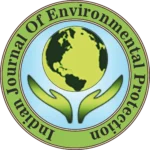IJEP 41(10): 1171-1176 : Vol. 41 Issue. 10 (October 2021)
T.S.R. Umamageswari*
PSNA College of Engineering and Technology, Department of Chemistry, Dindigul – 624 622, Tamil Nadu, India
Abstract
The study was carried out to analyze the heavy metal contamination in the groundwater of Tirunelveli district, Tamil Nadu. To get the extend of heavy metals contamination, water samples were collected from eleven different locations in the study area and the concentrations of heavy metals, such as iron, zinc, copper, lead and cadmium were determined using atomic absorption spectrophotometer (AAS). It is a well known fact that the heavy metal ions are potentially toxic to human health and could be quite detrimental for human life. Groundwater contamination by heavy metal was carried out using contamination factor, contamination degree, modified contamination degree, pollution load index, metal contamination index, enrichment factor and metal pollution index. Based on the above indices, it is shown that all heavy metals are present within the permissible limit and the study area is found to show very low degree of heavy metal pollution. It indicates the metals are entirely from crustal materials or natural processes.
Keywords
Contamination factor, Contamination degree, Enrichment factor, Pollution load index, Metal contamination index, Tirunelveli district
References
- Siddiquee, N.A., et al. 2006. Trace metal concentration in sediments of Chittagong ship breaking area. J. Noami. 23:23-30.
- MacDonald, D.D., et al. 1996. Development and evaluation of sediment quality guidelines for Florida and coastal waters. Ecotoxicol., 5:253-278.
- Burton, G.A., 2002. Sediment quality criteria in use around the world. Limnol., 3(2):65-76.
- Martincic, D., et al. 1989. Trace metals in sediments from the Adriatic sea. Sci. Total Env., 84:135-147.
- APHA. 1989. Standard methods for examination of water and wastewater (17th edn). American Public Health Association, Washington D.C., USA.
- Hakanson, L. 1980. An ecological risk index for aquatic pollution control – A sedimentological approach. Water Res., 14(8):975-1001.
- Nriagu, J.O. and J. M. Pacyna. 1998. Quantitative assessment of worldwide contamination of air, water and soils by trace metals. Nature. 333:134-139.
- Abrahim, G.M.S. 2005. Holocene sediments of Tamaki estuary : Characterization and impact of recent human activity on an urban estuary to Auckland, New Zeland. Ph.D. Thesis. University of Auckland, Auckland, New Zealand.
- Tomlinson, D.C., et al. 1980. Problems in the assessment of heavy metals levels in esturies and the formation of a pollution index. Helgol Wiss Meeresunters. 33:566-575.
- Turekian, K.K. and K.H. Wedepohl. 1961. Distribution of the elements in some major units of the earth’s crust. Geol. Soc. America Bull., 72:175-192.
- Mohiuddin, K.M., et al. 2010. Geochemical distribution of trace metal pollutants in water and sedi ments of downstream of an urban river. Int. J. Env. Sci. Tech., 7(1):17-28.
- Harikumar, P.S. and T.S. Jisha. 2010. Distribution pattern of trace metal pollutants in the sediments of an urban wetland in the southwest coast of India. Int. J. Eng. Sci. Tech., 2 (5):840-850.
- Meybeck, M.A., J. Horowitz and C. Grosbois. 2004. The geo-chemistry of Seine river basin particulate matter: Distribution of an integrated metal pollution index. Sci. Total Env., 328:219-236.
- Tamasi, G. and R. Cini. 2004. Heavy metals in drinking waters from Mount Amiata. Possible risks from arsenic for public health in the province of Siena. Sci. Total Env., 327-41-51.
- Lyulko, I., T. Ambalova and T. Vasiljeva. 2001. To integrated water quality assessment in Lativa, MTM) (monitoring tailor-made)-III. International Workshop on Information for sustainable water management, Netherlands. Proceedings, pp 449-452.
- Caerio, S., et al. 2005. Assessing heavy metal contamination in Sado estuary sediment : An index analysis approach. Ecol. Indic., 5:151-169.
- Simex, S.A. and G.R. Helz. 1981. Regional geochemistry of trace elements in Checapeake bay. Env. Geol., 3:315-323.
- Romero, A., I. Gonzalez and E. Galan. 2013. Trace elements absorption by citrus in a heavily polluted mining site. J. Geochem. Explor., 113:76-85.
- Shutherland, R.A. 2000. Bed sediment associated trace metals in an urban stream, Oahu, Hawaii. Env. Geol., 39:611-627.
- Stercekeman, T., et al. 2006. Trace elements in soil developed in sedimentary materials from northern france. Geoderma., 136:912-929.
- Buhijan, M.A.H., et al. 2010. Heavy metal pollution of coal mine affected agricultural soils in the northern part of Bangladesh. J. Hazard. Mater., 173 (1-3):384-392.
- Feng, H., et al. 2004. A preliminary study of heavy metal contamination in Yangtze river intertidal zone due to urbanization. Mar. Poll. Bull., 49(11-12):910-915.
- Abrahim, G.M.S. and R.J. Parker. 2008. Assessment of heavy metal enrichment factors and the degree of contamination in marine sediments from Tamaki estuary, Auckland, New Zealand. Env. Monit. Assess., 136(1-3):227-238.
- Sakan, S., et al. 2009. Assessment of heavy metal pollutants accumulation in Tisza river sediments. J. Env. Manage., 90:3382-3390.
